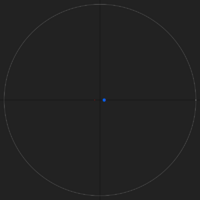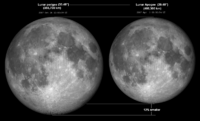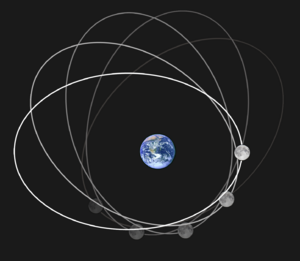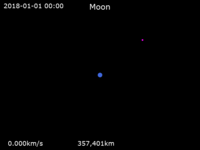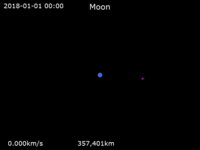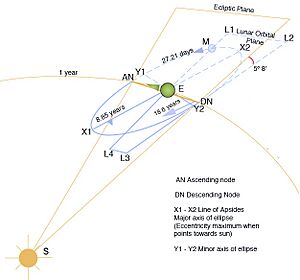Orbit of the Moon facts for kids

Diagram of the Moon's orbit with respect to the Earth. Angles are correct and relative sizes are to scale, but distances are not to scale.
|
|
| Semi-major axis | 384,748 km (239,071 mi) |
|---|---|
| Mean distance | 385,000 km (239,000 mi) |
| Inverse sine parallax | 384,400 km (238,900 mi) |
| Perigee | 363,228.9 km (225,700.0 mi), avg. (356400–370400 km) |
| Apogee | 405,400 km (251,900 mi), avg. (404000–406700 km) |
| Mean eccentricity | 0.0549006 (0.026–0.077) |
| Mean obliquity | 6.687° |
| Mean inclination | |
| of orbit to ecliptic | 5.15° (4.99–5.30) |
| of lunar equator to ecliptic | 1.543° |
| Period of | |
| orbit around Earth (sidereal) | 27.322 days |
| orbit around Earth (synodic) | 29.530 days |
| precession of nodes | 18.5996 years |
| precession of line of apsides | 8.8504 years |
The Moon travels around Earth in a path called an orbit. It moves in the same direction as Earth's rotation (prograde). The Moon takes about 27.32 days to complete one trip around Earth compared to distant stars. This is called a sidereal month.
It takes about 29.53 days for the Moon to complete one trip compared to the Sun. This is called a synodic month. This longer period is why we see the Moon's phases change.
Earth and the Moon actually orbit around a shared center of gravity. This point is called their barycentre. It's located about 4,670 km (2,900 mi) from Earth's center. This means the Earth and Moon form a satellite system together. On average, the Moon is about 385,000 km (239,000 mi) away from Earth's center.
The Moon moves at an average speed of 1.022 km/s (0.635 miles/s). This means it covers a distance equal to about half a degree on the celestial sphere every hour. Unlike most moons, the Moon's orbit is closer to the ecliptic plane. The ecliptic is the path the Sun appears to take across the sky. The Moon's orbital plane is tilted by about 5.1° compared to the ecliptic. Earth's own equator is tilted by about 23° to the ecliptic.
Contents
How the Moon's Orbit Works
The Moon's orbit around Earth isn't perfectly simple. Many small changes, called perturbations, happen. These are caused by the gravity of the Sun and other planets. Scientists have studied these changes for a long time.
The Moon's Ellipse-Shaped Path
The Moon's orbit is shaped like a slightly stretched circle, called an ellipse. It's almost a perfect circle, with only a small difference between its longest and shortest parts. This slight stretch is measured by its eccentricity, which is 0.0549.
Because the orbit is an ellipse, the Moon's distance from Earth changes.
- When the Moon is closest to Earth, it's at its perigee. This distance is about 362,600 km (225,300 mi).
- When the Moon is farthest from Earth, it's at its apogee. This distance is about 405,400 km (251,900 mi).
When the Moon is at perigee, it looks bigger in the sky. This is because it's closer to us. A "supermoon" happens when a full Moon is at its perigee. It looks about 12% larger and 25% brighter than when it's at apogee.
The Moon's speed also changes. It moves faster when it's closer to Earth and slower when it's farther away. This follows Kepler's second law of planetary motion.
Moon's Position Relative to the Sun
The Moon's elongation is how far it appears from the Sun in the sky.
- At new moon, the Moon is between Earth and the Sun. Its elongation is zero. This is called conjunction.
- At full moon, Earth is between the Moon and the Sun. Its elongation is 180°. This is called opposition.
In both cases, the Sun, Moon, and Earth are almost in a straight line. This alignment is known as syzygy. When the elongation is 90° or 270°, the Moon is in quadrature. This is when we see a first quarter moon or last quarter moon.
The Moon's Orbit Shifts Over Time
The Moon's orbit doesn't stay in the exact same spot in space. It slowly rotates over time. This movement is called orbital precession.
The longest part of the Moon's elliptical orbit, which connects its closest (perigee) and farthest (apogee) points, rotates. It makes one full turn every 8.85 Earth years. This rotation happens in the same direction that the Moon itself moves. This is called apsidal precession. It's different from other types of precession, like the tilt of the Moon's axis.
The Tilt of the Moon's Orbit
The Moon's orbit is tilted by about 5.145° compared to the ecliptic plane. This tilt is important because it explains why we don't have eclipses every month. If the Moon's orbit wasn't tilted, the Moon would pass directly in front of or behind the Sun every time it was new or full.
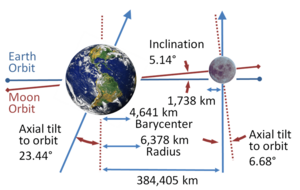
The Moon's own spinning axis is also tilted. It's not straight up and down compared to its orbit. This tilt is about 6.688°. Because of this tilt, we can sometimes see a little bit more of the Moon's north or south pole. This slight wobble is called libration in latitude.
Where the Orbit Crosses the Ecliptic
The points where the Moon's orbit crosses the ecliptic plane are called nodes. The Moon crosses the same node every 27.2122 days. This period is known as a draconic month.
The line connecting these nodes also moves. It rotates westward along the ecliptic over about 18.6 years. This means that the nodes are constantly shifting. Eclipses can only happen when the Sun, Earth, and Moon are aligned, and the Moon is also near one of these nodes. This happens roughly every 173.3 days.
Lunar Standstill
Every 18.6 years, the angle between the Moon's orbit and Earth's equator reaches its largest point, about 28°36′. This is called a major lunar standstill. During this time, the Moon rises and sets at its most extreme northern and southern points on the horizon.
About 9.3 years later, the angle reaches its smallest point, about 18°20′. This is called a minor lunar standstill. The last minor standstill was in October 2015.
At higher latitudes, like near the Earth's poles, the Moon's tilt means it can stay above the horizon for almost two weeks every month. This happens even when the Sun is below the horizon for months at a time during winter. The Moon's light is important for animals in the Arctic and Antarctic during these long, dark periods.
A Scale Model of Earth and Moon
How We Learned About the Moon's Orbit
Around 1000 BC, the Babylonians were the first people known to keep detailed records of the Moon. They wrote down when the Moon rose and set. They also noted which stars the Moon passed near. The Babylonians discovered the main patterns of the Moon's movement. They used this information to create calendars that predicted future lunar events. This was one of the first examples of scientific study.
Later, Ancient Greek astronomers like Ptolemy created mathematical models to explain the Moon's motion. They used ideas like epicycles to describe its complex path.
Much later, Isaac Newton developed his theory of gravity. He used observations of the Moon's motion to test and prove his ideas.
Different Lunar Periods
The Moon has several different periods related to its orbit.
| Name | How Long It Is (days) | What It Means |
|---|---|---|
| Sidereal month | 27.321662 | The time it takes for the Moon to orbit Earth once, compared to distant stars. |
| Synodic month | 29.530589 | The time it takes for the Moon to go through all its phases (e.g., new moon to new moon). |
| Tropical month | 27.321582 | The time it takes for the Moon to return to the same point relative to the vernal point (a specific point in space). |
| Anomalistic month | 27.554550 | The time between two closest approaches of the Moon to Earth (perigees). |
| Draconic month | 27.212221 | The time it takes for the Moon to cross its ascending node (where its orbit crosses the ecliptic) twice in a row. |
The sidereal month is about 27.32 days. The synodic month is longer, about 29.53 days. This is because Earth and the Moon are also moving around the Sun. So, the Moon needs a bit more time to catch up and show the same phase again. The anomalistic month is about 27.55 days. It measures the time between the Moon's closest approaches to Earth.
The average length of a calendar month (about 30.4 days) is not a true lunar period. However, our calendar months are historically linked to the Moon's phases.
How Tides Affect the Moon's Orbit
The Moon's gravitational pull causes tides on Earth. These tides affect both the oceans and the solid ground. The Sun also causes tides, but its effect is smaller than the Moon's.
Earth rotates faster than the Moon orbits. This causes a slight bulge in Earth's oceans and land. This bulge is pulled by the Moon's gravity. This pull creates a tiny force that slows down Earth's rotation. At the same time, it slightly speeds up the Moon in its orbit.
This transfer of energy means that Earth's rotation is gradually slowing down. Our days are getting about 24 microseconds longer each year. Also, the Moon is slowly moving farther away from Earth. It moves about 38 millimeters (about 1.5 inches) farther away each year.
Scientists have studied ancient rock formations that show tidal patterns from millions of years ago. These show that the Moon used to be closer to Earth. It also shows that Earth's days were shorter in the past. For example, 620 million years ago, the Moon was moving away at about 22 millimeters per year. Earth's day was getting longer by about 12 microseconds per year.
Scientists believe the Moon will continue to move away for about 50 billion years. Eventually, the Moon and Earth might become tidally locked. This means they would both rotate at the same speed, always showing the same side to each other. The Moon is already tidally locked to Earth. However, Earth's oceans will likely evaporate in about 2.3 billion years due to the Sun getting hotter. This would stop the tidal effects before Earth becomes fully tidally locked.
Why the Moon Seems to Wobble
The Moon is in synchronous rotation. This means it always shows the same side to Earth. But this is only true on average. The Moon's orbit is not a perfect circle. So, its speed changes as it orbits Earth. The Moon's own rotation speed stays pretty constant.
This difference in speeds causes the Moon to appear to wobble slightly. This wobble is called libration.
- When the Moon is closest to Earth (perigee), it moves faster in its orbit than it rotates. This lets us see a little bit more of its eastern (right) side.
- When the Moon is farthest from Earth (apogee), it moves slower than it rotates. This lets us see a little bit more of its western (left) side. This is called optical libration in longitude.
The Moon's axis of rotation is also tilted. This tilt causes us to see a little bit more of the Moon's north or south pole. This is called optical libration in latitude.
Finally, because we are on Earth's surface, our view of the Moon changes slightly throughout the night as Earth rotates. This allows us to see a tiny bit more of the Moon's edges. This is called diurnal libration.
Besides these apparent wobbles, the Moon also has very tiny actual wobbles in its rotation. These are called physical librations.
Earth and Moon's Journey Around the Sun
If you could look down on our Solar System from above the North Pole, you would see everything spinning counter-clockwise. The Moon orbits Earth counter-clockwise. Earth orbits the Sun counter-clockwise. Both Earth and the Moon also spin on their own axes counter-clockwise.
Sometimes, diagrams show the Moon orbiting Earth as if it makes loops or goes backward from the Sun's point of view. But this isn't true. The Moon's speed around Earth (1 km/s) is much slower than Earth's speed around the Sun (30 km/s). So, the Moon always moves forward in its path around the Sun. It never makes backward loops.
The Earth and Moon together form a binary planet system. Their shared center of gravity (barycentre) is inside Earth. It's about 4,671 km (2,902 mi) from Earth's center. As Earth and the Moon orbit the Sun, this barycentre is what follows the smooth path. Earth's center actually wobbles slightly around this barycentre each month.
The Sun's gravity pulls on the Moon more than Earth's gravity does. Because of this, the Moon's path around the Sun is always curved outwards, or convex. It never curves inwards or makes loops when seen from far away.
See also
 In Spanish: Órbita de la Luna para niños
In Spanish: Órbita de la Luna para niños
- Ernest William Brown
- Double planet
- List of orbits
- Ephemeris
- Lunar Laser Ranging experiment
- Milankovitch cycles
- Orbital elements


